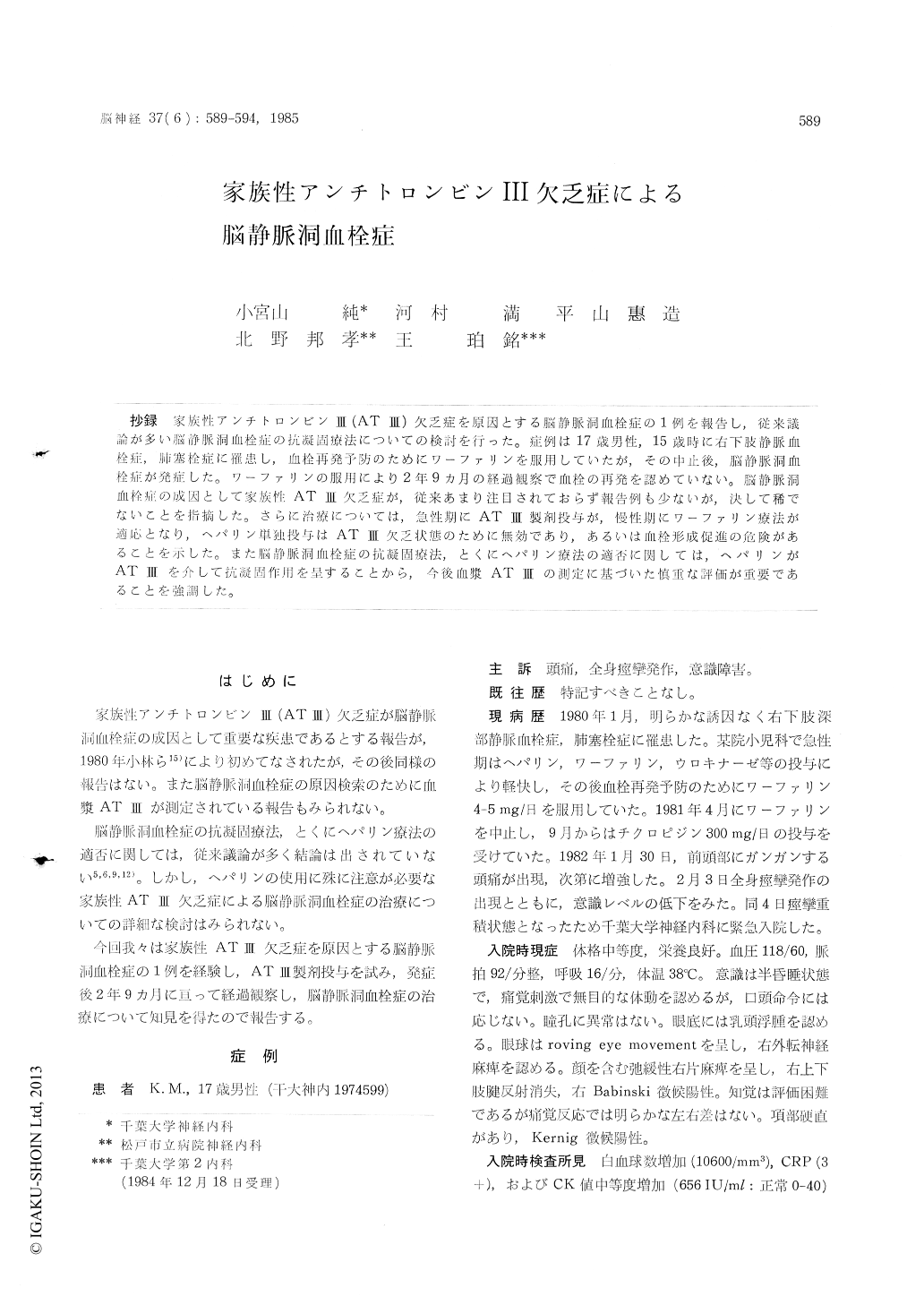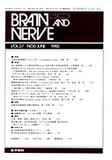Japanese
English
- 有料閲覧
- Abstract 文献概要
- 1ページ目 Look Inside
抄録 家族性アンチトロンビンIII (AT III)欠乏症を原因とする脳静脈洞血栓症の1例を報告し,従来議論が多い脳1静脈洞血栓症の抗凝固療法についての検討を行った。症例は17歳男性,15歳時に右下肢静脈血栓症,肺塞栓症に罹患し,血栓再発予防のためにワーファリンを服用していたが,その中止後,脳静脈洞血t栓症が発症した。ワーファリンの服用により2年9カ月の経過観察で血栓の再発を認めていない。脳静脈洞血栓症の成因として家族性ATIII欠乏症が,従来あまり注目されておらず報告例も少ないが,決して稀でないことを指摘した。さらに治療については,急性期にAT III製剤投与が,慢性期にワーファリン療法が適応となり,ヘパリン単独投与はATIII欠乏状態のために無効であり,あるいは血栓形成促進の危険があることを示した。また脳静脈洞血栓症の抗凝固療法,とくにヘパリン療法の適否に関しては,ヘパリンがAT IIIを介して抗凝固作用を呈することから,今後血漿AT IIIの測定に基づいた慎重な評価が重要であることを強調した。
A case of cerebral venous thrombosis with familial antithrombin III (AT III) deficiency was reported and we discussed the anticoagulant therapy of cerebral venous thrombosis from the viewpoint of AT III. The patient, a 17-year-old boy, was admitted to our clinic with severe bifrontal headache, generalized convulsions and progressive disturbance of consciousness. He developed deep vein thrombosis in his right legand pulmonary emboli two years earlier when he was placed on heparin and so forth, follow-ed by warfarin sodium. Warfarin was term-inated 9 months prior to his recent illness. On neurological examination on admission, he was semicomatous with blurred disc margins, roving eye movements with right abducens nerve palsy, nuchal stiffness and right flaccid hemiplegia. Left carotid angiogram and CT scan revealed extensive superior sagittal sinus thrombosis, complicated with hemorrhagic infarcts in bilat-eral frontal lobes. When examined for coagu-lation studies, the patient and his father had decrease in AT III activity and antigen levels. He was treated successfully with antiedematous agents and anticas thereafter placed on war-farin 5-6 mg/onvulsants during acute phase of illness. He wday with no further clinical throm-boembolic event for 2 years 9 months. There was no neurological abnormality when he was last examined, although he was treated with valproic acid 1,200 mg/day and phenytoin 250 mg/day to control occasional adversive seizures.
A coagulation study following infusion of 5,000 units of AT III was carried out.War-farin was discontinued the day before the study. 0.64 U/kg of AT III administration resulted in a 1% increase in AT III level after the infu-sion. The biological half life of AT III was 14.4 hours. Warfarin, however, had to be re-administered on the third day because he deve-loped hypercoagulable state with decreased level of AT III below normal.This result clearly demonstrated effectiveness of warfarin as an anticoagulant.
The condition of hemorrhagic infarction deve-loped after heparin administration in patients with cerebral venous thrombosis is assumed to be caused by following states : 1) heparin is not effective to prevent thrombus formation because of AT III deficiency and 2) AT is consumed by heparin administration resulting in accerel-ated thrombus formation. Therefore, we would emphasize that anticoagulant therapy, especially heparinization,in cerebral venous thrombosis should be carefully started after plasma AT III level determination.

Copyright © 1985, Igaku-Shoin Ltd. All rights reserved.


